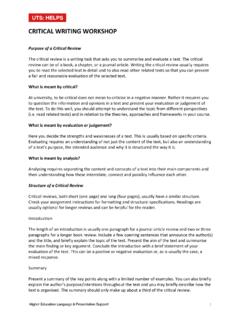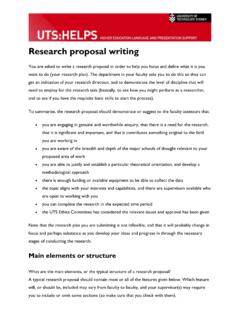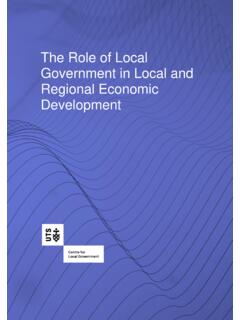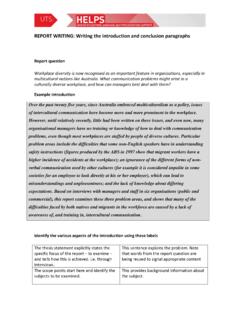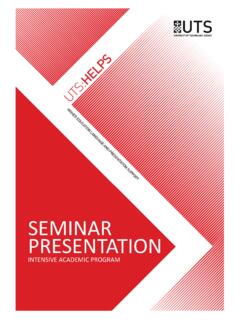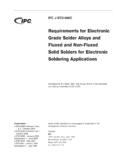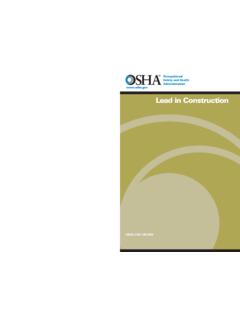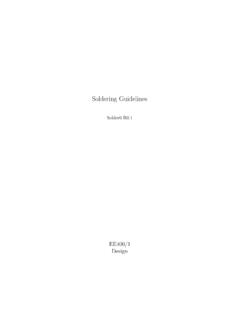Transcription of Soldering - University of Technology Sydney
1 1 RN Contents Index 2016 Soldering Contents Introduction .. 2 1 Soldering Printed Circuit Boards .. 3 2 Types of solder .. 4 3 Types of PCB .. 5 Through-Hole Components .. 5 Surface Mount Components .. 5 4 Flux .. 6 5 Soldering Irons .. 7 Tips .. 8 Tip Contamination and Cleaning .. 9 6 Ovens and Hot Plates .. 10 7 Desoldering .. 11 8 Hazards involved in Soldering .. 12 Heat .. 12 Toxic materials .. 12 Spattering .. 13 Electrical Safety .. 13 2 Index Introduction RN Soldering 2016 Introduction Soldering is a process used for joining metal parts to form a mechanical or electrical bond. It typically uses a low melting point metal alloy ( solder ) which is melted and applied to the metal parts to be joined and this bonds to the metal parts and forms a connection when the solder solidifies.
2 It is different to welding in that the parts being joined are not melted and are usually not the same material as the solder . Soldering copper pipe Sheet metal fabrication Figure 1 Different Types of Soldering Soldering is a common practice for assembling electrical components and wiring. Although it can be used for plumbing, sheet metal fabrication or automotive radiator repair the techniques and materials used are different to those used for electrical work. This document is intended to provide guidance on the safe working methods and proper tools and techniques for Soldering of electrical components. 3 RN Soldering Printed Circuit Boards Index 2016 Soldering 1 Soldering Printed Circuit Boards Soldering may be used to join wires or attached components to a printed circuit board (PCB).
3 Wires, component leads and tracks on circuit boards are mostly made of copper. The copper is usually covered with a thin layer of tin to prevent oxidization and to promote better bonding to other parts with solder . When Soldering bare copper wires they are often tinned by applying molten solder before making a joint. Hand Soldering components on PCB Industrial oven for surface mount Figure 2 Different Types of PCB Soldering 4 Index Types of solder RN Soldering 2016 2 Types of solder There are different types of solder used for electrical work. They are broadly classified as tin/lead solders or lead free solders.
4 Tin/lead solders have been used for many years because of their ease of use however they have been phased out of commercial use due to the harmful effects on humans and the environment. Tin/ lead solder is still available and is used by hobbyists and other non-commercial users as it is still easier to use than lead free types. When using tin/lead (or leaded) solder there are additional safety precautions that must be observed. Different gauges of solder wire solder composition is labelled (Lead free on left) Figure 3 Different Types of solder 5 RN Types of PCB Index 2016 Soldering 3 Types of PCB Printed circuit boards (PCBs) are populated by electronic components and these may be surface mount or through-hole types.
5 Through-Hole Components As the description through-hole suggests, the leads of the component are passed through holes in the PCB and then soldered to a pad on the reverse side of the PCB. Soldering is accomplished by heating the component lead and PCB pad with a Soldering iron and melting solder wire into the joint. This type of construction was common from the 1960 s until early 2000 s and is still used by hobbyists and in small scale production where manual assembly is preferred. Surface Mount Components Commercial circuits are mostly of the surface mount type as these are cheaper to make, more compact and easier to automate assembly.
6 For surface mount construction the component s pads are on the same side of the PCB as the component and the component connections sit onto these pads. Soldering is accomplished by applying solder paste onto component pads on the PCB, placing the component onto the paste and then heating the entire assembly to melt the solder . Commercial assembly uses ovens to heat the boards. Hobbyists can also use surface mount components and Soldering can be accomplished by applying solder paste and melting with a hot plate, small oven or Soldering iron. Some surface mount joints can be soldered using a Soldering iron and solder wire.
7 Through-hole PCB (non-component side) Surface mount PCB (component side) Figure 4 Different Types of PCB 6 Index Flux RN Soldering 2016 4 Flux For electrical Soldering both solder wire and solder paste contain flux. This helps to clean the surfaces being soldered and prevent oxidization of the hot solder . The composition of the flux will vary depending on whether it is in a paste or wire, leaded or unleaded solder . solder wire usually contains a flux called rosin . Most fluxes will produce fumes when the solder is heated and these fumes are likely harmful to your health. For occasional Soldering it may be sufficient to have a well-ventilated workspace but for longer or repeated exposure a fume extractor should be used.
8 solder flux can also cause solder to spatter and eye protection should be worn when Soldering . Fumes produced when Soldering Workstation with fume extraction system Figure 5 Fumes and Fume Extraction Systems 7 RN Soldering Irons Index 2016 Soldering 5 Soldering Irons Soldering irons come in many varieties and sizes. Soldering irons may be electric, gas powered or externally heated. Most common types are electric. Simple electric Soldering irons have no controls and you simply plug them in and wait for them to heat up. Their temperature is regulated by the power of the heating element and heat loss to the environment.
9 Some Soldering irons have temperature controls which allow the user to set a desired operating temperature for the Soldering iron. This is useful if the Soldering iron is being used for different types of solders which have different melting points or if the Soldering iron is being used for other purposes such as heating heatshrink. It also introduces a problem if the user does not set an appropriate temperature for the work, solder can be overheated and decompose. Hotter is not better! A temperature of around 320 C works well for 60/40 leaded solder . Some temperature controlled Soldering irons use interchangeable tips to change the temperature at which they operate.
10 A range of electric Soldering irons Choose an iron appropriate for your task! Figure 6 Types of Soldering irons 8 Index Soldering Irons RN Soldering 2016 Adjustable temperature Soldering stations Different tips set the temperature for this station Figure 7 Types of Soldering stations Tips Heat is transferred from the tip of the Soldering iron to the joint by thermal conduction enabled by metal to metal contact between the tip and joint. The tips of Soldering irons come in various shapes and sizes to enable the best contact to be made. Most tips are either conical or chisel shapes. The shape is largely a personal preference and you can use whichever type works best for you.
